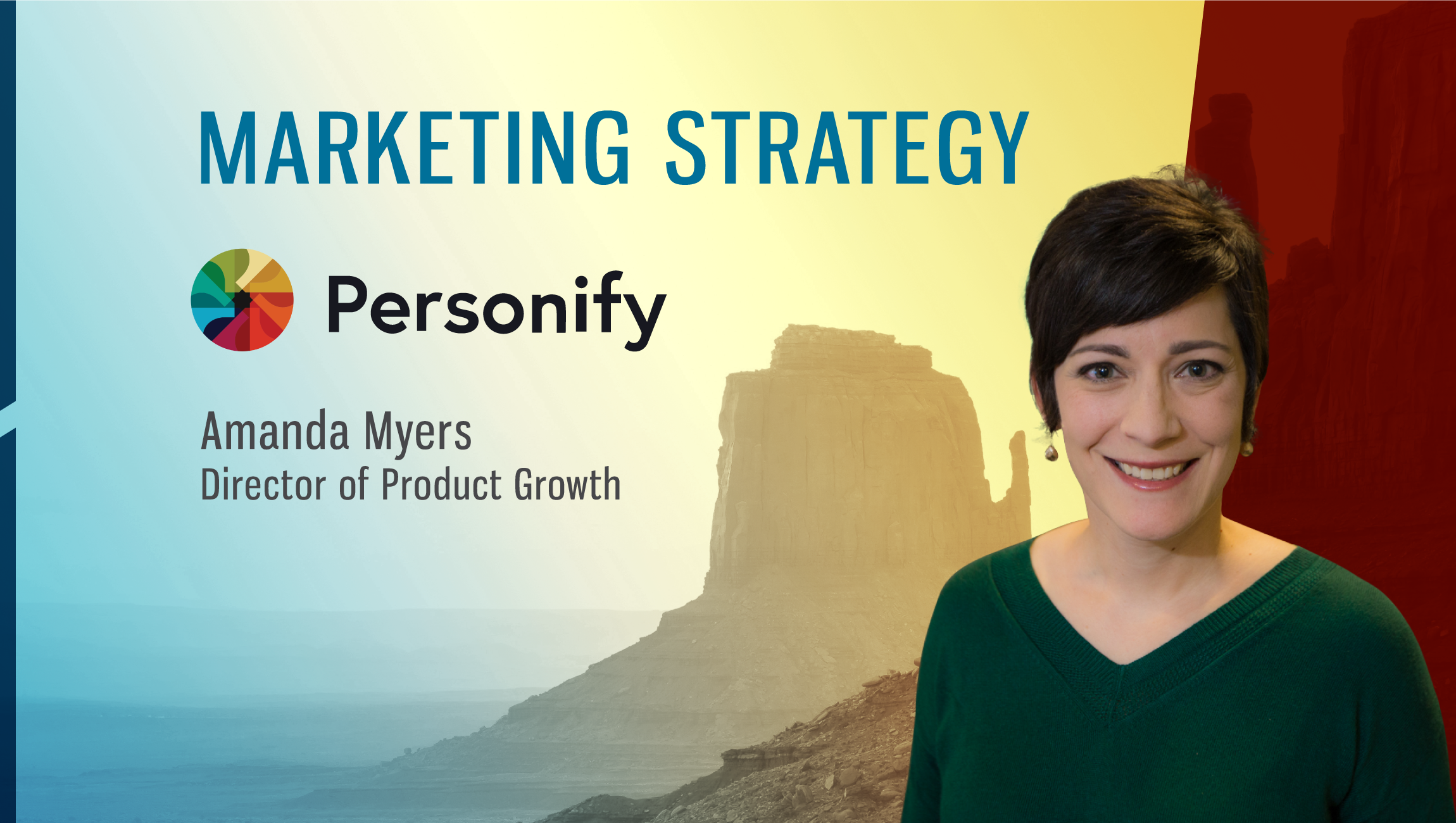Amanda Myers
Director, Product Growth at Personify Corp
Online communities provide a tremendous advantage for organizations to bring their supporters, fans and followers together in a branded online destination. We spoke to Amanda Myers, Director of Product Growth at Personify Corp, to understand how they leverage the ‘Power of Community’ with Marketing Automation and Social Media tools.
Html code here! Replace this with any non empty text and that's it.
Tell us about your role at Personify and the team/technology you handle.
I serve as Personify’s Director of Product Growth. As a marketer, my role is to drive awareness of, and interest in, all products within our portfolio but it’s really much more than that. I’m responsible for building a deep understanding of our non-profit clients and aligning our technologies to their mission. How can we help them be better, do more? As such, I spend a lot of time researching trends within the non-profit sector and writing thought leadership content to support these organizations.
What was the most disruptive moment of 2018 in the web-based products market? How do you see it impacting your business?
The non-profit sector mirrors commercial businesses in a number of ways and donor- and member-centric organizations are also seeing disruption from well-documented trends, including Artificial Intelligence and the continued evolution of the Internet of Things.
But if you take the dictionary definition of disruption as a disturbance that interrupts an event, activity or process, some of the most disruptive events to the non-profit sector in 2018 probably stem from Facebook. In mid-March, media outlets reported that 50 million Facebook profiles were harvested for Cambridge Analytica in a major data scandal — and the number was later revised to 87 million Facebook profiles. As recently as October, another 30 million accounts were compromised, and hackers were able to gain access to names and phones numbers of nearly all of those users as well as personal details such as birth dates, relationship status, gender, education and work histories for 14 million of them.
Facebook’s Q3 earnings call confirmed US and Canada daily active users have been flat at 185 million since Q1 of 2018, and daily active users in Europe declined to 278 million, down from 279 million in Q2 and 282 million in Q1. We’re also noticing a shift in the behavior of younger users. According to a recently published study from the Pew Research Center, just 51% of US individuals 13 to 17 say they use Facebook, a dramatic plunge from the 71% who reported using the social network in Pew’s previous study, fielded in 2015.
The result? Many non-profits, who have relied on Facebook as a cost-effective means of driving visibility and engagement, are having to reconsider its role in their digital marketing mix and Social Media strategy. For our business, ensuring non-profits understand the potential impact and are in a position to be proactive in understanding their options is hugely important.
How do you leverage the ‘Power of Community’ with Marketing Automation and Social Media tools?
In the non-profit sector, the power of community takes on additional importance — it’s how these organizations look to create social change. Online communities provide a tremendous advantage for organizations to bring their supporters, fans and followers together in a branded online destination — it mitigates the risks of depending on a third-party provider alone.
Using these communities with Marketing Automation and Social Media tools can amplify their efforts, allowing them to reach more potential members, donors and volunteers. Integrating communities with social Media, instead of relying on Social Media as a community, allows organizations to leverage the visibility provided by Social Media to drive traffic to the community, which provides richer opportunities for dialogue and conversation. Sharing the data with Marketing Automation can fuel highly personalized experiences, deepening engagement and the relationship. The same holds true in our organization.
What kind of tools do you create at Personify to leverage this power?
Knowledge is true power! We want non-profits to have total visibility into their constituents — members, donors and volunteers — so they can focus on their mission, not managing their technology.
We’ve designed solutions that work together to create the best possible experience for our clients and their daily needs, but also for their constituents. Our Personify Community product has been uniquely designed for the needs of non-profits, with forums, groups, blogs and gamification to encourage and motivate constituents.
Non-profits can connect Community to our Personify 360 product, a purpose-built CRM that captures interactions and creates robust views of a non-profit’s supporters and their interactions. And our Personify Hub product connects both to Marketing Automation tools to connect disparate Marketing Technologies together and integrate their data streams and workflows. We’ve taken great care to ensure everything works together to deliver a clear picture.
Given the holiday season, why do organizations and companies need to tailor their marketing strategies to different generations in the marketplace – from Baby Boomers to the new Gen Z?
As non-profits enter into the thick of the holiday giving season, the first place to start with generations is to understand how they behave and their communication preferences — this ensures you’re not only getting the right message out but that donors are also receiving the messages. We’ve developed materials to help provide context here including some statistics that surprised even me — for example, two-thirds of Baby Boomers have a smartphone. Are you including them in text-to-give outreach efforts?
But one of the greatest untapped potential growth areas continues to be younger members and donors. On average, 51% of millennials give an average of $591 across 3.5 charities while 44% of Gen Z, the oldest of whom are just now reaching the age of 21, already give an average of $341 across 4.6 charities. And, both generations are willing to fundraise for an organization they’re passionate about and almost half prefer asking people to replace physical birthday gifts with a donation to a specific non-profit. Could you engage them to amplify support for your cause? Could you extend your year-end campaigns with a peer-to-peer component, allowing supporters to solicit funds from friends and family in lieu of holiday gifts?
What are your predictions on creating digital collaboration tools and communities as part of “Digital Transformation”?
In the non-profit sector, communities connect people, allowing them to discuss shared areas of interest and exchange ideas. It empowers collaboration in a more personal, effective way, beyond digital collaboration tools often relied upon by our commercial business peers (e.g. document sharing, real-time editing).
But for mission-focused non-profits, this type of collaboration is ultimately more impactful. Digital transformation allows non-profits to be hyper-focused on the marketing activities that yield the highest levels of impact, making the most of (often) limited resources. Introducing community allows them the ability to leverage the communication and the collaboration they facilitate to boost fundraising effectiveness, improve volunteer engagement and deepen commitment, supporting strong retention. The constituent interaction with one another becomes a complement to an organization’s own marketing and communication activities. The online community may only represent one tool but delivers multiple benefits as part of a digital transformation effort.
What lies ahead for Marketing Technology teams in 2019? Any event that you are particularly following the next year?
We’re following a number of trends in Marketing Technology to understand them not only within our own organization but in terms of how they can support non-profits. Like many others, AI continues to be near the top of the list. As part of their 2019 predictions, Gartner recently stated:
- Through 2020, 80% of AI projects will remain alchemy, run by wizards whose talents will not scale in the organization. (Source: Gartner)
- When asked what’s holding back your organization in adopting AI, 79% attribute it to “fear of the unknown.” (Source: Gartner Symposium)
AI has been oft-discussed but remains unattainable for so many. I think, 2019 will see many organizations reposition AI in highly-focused, practical ways that drive more immediate value. Forrester’s 2019 B2B predictions suggest using AI in Marketing Technology to better optimize mid-cycle engagement. I think advancements in Natural Language Processing (NLP) will make the introduction of more effective chatbots increasingly accessible, providing an additional layer of service to internal employees and constituents alike.
How could this aspect of digital transformation drive better team performance?
While digital transformation has made some people nervous, I think it’s empowered marketers and created a sort of “Golden Age.” Never before have we had access to so much information nor the ability to apply it with such tailored results. Incorporation of AI as noted above in improving mid-cycle engagement allows us to not only speed along potential sales to drive results for our business, but to create meaningful experiences for prospects and clients. NLP-powered chatbots create additional efficiency, allowing marketers to spend their time on more strategic activities to move their brand forward. This is true for my role at Personify but also for the non-profits we serve.
How do you consume all the information related to the digital marketing industry?
With a great deal of caffeine and an open mind!
Thanks for chatting with us, Amanda.
Stay tuned for more insights on marketing technologies. To participate in our Tech Bytes program, email us at news@martechseries-67ee47.ingress-bonde.easywp.com











